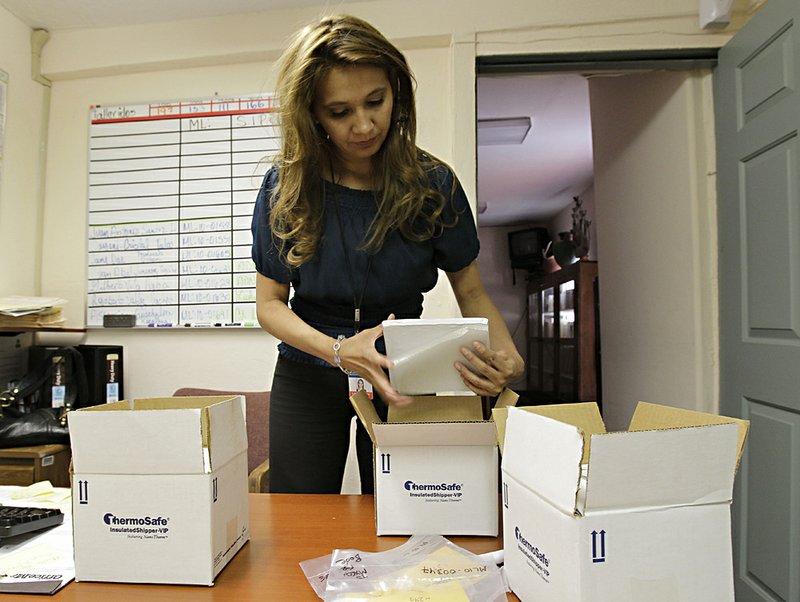WASHINGTON — Lorenia Ton visits the morgues of southern Arizona searching for clues among the unclaimed bodies and belongings of people who tried to cross the desert.
Sometimes it’s a phone number written inside pant legs, or a piece of paper sewn into a backpack. Other times there are family photos, images of saints, or love letters.
“Sometimes we cannot find anything,” says Ton, whose job at the Mexican Consulate in Tucson involves helping identify the remains and return them to Mexico.
To confirm the identifications, the consulate sends DNA samples to Bode Technology Group Inc., a private lab in Lorton, Va., outside Washington, as part of a project that has brought closure to dozens of families and countless relatives on both sides of the dangerous border.
During one trip in April, Ton came across a body recently discovered by a hunter. Found with the dead man were his tennis shoes, a belt, a couple of dollars and pesos, a wallet, a baseball cap, and voter identification card. Ton had a name: Agustin Gutierrez Ortiz, 34.
Jesus Gutierrez Ortiz, 37, who lives in Bradley Beach, N.J., described his brother as a hardworking father of two who left their hardscrabble town of La Natividad in the state of Oaxaca to help his family. He reported the younger Gutierrez Ortiz missing to Mexican authorities in June 2009, and Bode confirmed the worst a year later.
“I always asked God that he be alive, but in my heart I felt that he was dead because he was in the desert,” Gutierrez Ortiz says in Spanish. “If I could have flown into the desert ... to look for him I would have.”
The lab has made at least 47 positive identifications since the program began a couple of years ago. Many other cases are pending as the number of people who try to cross the border illegally has grown.
The number of deaths along the border hit a peak of 492 in 2005 and had been declining, according to U.S. Customs and Border Protection. But last year, the agency recorded 422 deaths, up from 390 the previous year. Most deaths are attributed to the heat.
As of Aug. 31, the most recent figures available, there had been 332 deaths this year.
But those numbers tally only the deaths that border patrol officers come across. That doesn’t include countless other bodies found by local law enforcement agencies, alien-rights organizations, ranchers and other passers-by.
The bodies that Bode Technology receives mainly come from Arizona. In that state, deaths of illegal aliens rose over the summer despite many who thought the state’s new law cracking down on immigration would send people elsewhere along the border.
The remains are found along known routes used by migrants. Some remains have been in the desert a year or more, leaving the bodies mummified or mere bones. Others are more recent.
Back in Mexico, families enter their loved ones into a vast missing-persons database, which includes details such as people’s clothes, dental records and whether they had tattoos.
If officials find a name with the bodies, they run it through the database. If the body is still recognizable, Ton sends a photo to the family. If the body is not too decomposed, officials can run the fingerprints with U.S. border authorities and see whether that person had been deported before.
On the basis of those leads, the consulate makes presumptive identifications. It’s Ton’s job to contact the relatives.
Ton says the relatives often tell her the deceased left home seeking better opportunities, looking to make money or raise a family. Some call her daily asking for updates on their cases.
But DNA testing is needed for final confirmation. Bode Technology, whose experts have helped identify victims from wars in Bosnia and Argentina and from Hurricane Katrina, receives bone fragments and compares them with samples sent from living relatives.
In some cases, a mother and a daughter or other relatives who died together also have been identified together.
The DNA matching process can cost between $900 and $1,200 per identification. Families then have the option of having the remains cremated, which costs another $800, or sent to them intact, which can cost from $1,500 to $2,800. The Mexican government foots the bill.
“The dead should not go unacknowledged,” says Julian Etienne, a Tucson consulate spokesman. “If you don’t identify them, they’re just going to be numbers.”
In cases in which there’s no indication of the person’s identity, the lab creates DNA profiles, which are sent back to Mexican authorities. The lab has received about 260 such samples since the beginning of this year.
Information for this article was contributed by Jacquelyn Martin and Jessica Gresko of The Associated Press.
Front Section, Pages 2 on 11/27/2010
